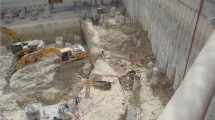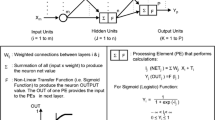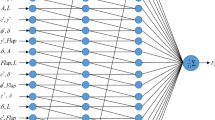Abstract
A new method was proposed to predict the compressive bearing capacity of driven piles based on the number of hammer strikes in the last one meter of pile penetration (known here as Flap number). To collect the data, a literature review was done on technical publications and pile driving record reports that were accessible to the authors at the time of publication. The data of a hundred driven piles including Flap number, basic properties of the surrounding soil, pile geometry, and pile-soil friction angle was collected. These data were initially used in the artificial neural network to establish a relation for predicting pile capacity. Subsequently, by using genetic programing and linear regression, equations for determining pile bearing capacity with respect to the Flap number, soil parameters, and pile geometries were proposed. Finally, the performance of all applied methods in predicting the pile bearing capacity were compared. The utmost importance was given to the comparison of the accuracy of the three models as well as the error estimation.
Similar content being viewed by others
References
Abu Kiefa, M. A. (1998). “General regression neural networks for driven piles in cohessionless soils.” Journal of Geotechnical and Geoenvironmental Engineering, Vol. 124, No. 12, pp. 1177–1185.
Alkroosh, I. and Nikraz, H. (2012). “Predicting axial capacity of driven piles in cohesive soils using intelligent computing.” Journal of Engineering Applications of Artificial Intelligence, Vol. 25, pp. 618–627.
Ardalan, H., Eslami, A., and Nariman-Zadeh, N. (2009). “Piles shaft capacity from CPT and CPTu data by polynomial neural networks and genetic algorithms.” Computers and Geotechnics, Vol. 36, pp. 616–625.
Banimahd, M., Yasrobi, S. S., and Woodward P. (2005). “Artificial neural network for stress-strain behavior of sandy soils: Knowledge based verification.” Computers and Geotechnics, Vol. 32, No. 5, pp. 377–386.
Bowles, J. E. (1997). Foundation analysis and design, McGraw-Hill, Peoria, IL.
Caglar, N. and Arman, H. (2007). “The applicability of neural networks in the determination of soil properties.” Bulletin of Engineering Geology and the Environment, Vol. 66, No. 1, pp. 295–301.
Caudill, M. (1988). “Neural networks primer: Part III.” AI Expert, pp. 52–59.
Chan, W. T., Chow, Y. K., and Liu, L. F. (1995). “Neural network: An alternative to pile driving formulas.” Computers and Geotechnics, Vol. 17, pp. 135–156.
Erzin, Y., Rao, B. H., and Singh, D. N. (2008). “Artificial neural networks for predicting soil thermal resistivity.” International Journal of Thermal Sciences, Vol. 47, No. 10, pp. 1347–1358.
Eslami, A. (1996). Bearing capacity of piles from cone penetration data, PhD Thesis, University of Ottawa, Ottawa, Canada.
Fatehnia, M. and Hataf, N. (2011). “Determination of the compressive capacity of driven piles using flap number.” Proc., Int. Conf. on Advances in Geotechnical Engineering, Curtin University, Perth, Australia, pp. 1027–1032.
Fellenius, B. H. (1989). “Predicted and observed axial behavior of piles.” Proc., Symp. on Driven Pile Bearing Capacity Prediction, American Society of Civil Engineers, New York, pp. 75–115.
Fellenius, B. H. and Altaee, A. (2002). “Pile dynamics in geotechnical practice- six case histories.” Proc., Int. Deep Foundation Cong., Down to Earth Technology, American Society of Civil Engineers, Orlando, Florida, pp. 619–633.
Hansen, B. J. (1963). “Discussion on hyperbolic stress-strain response, cohesive soils.” Soil Mechanics and Foundation Engineering, Vol. 89, No. 4, pp. 241–242.
Javidi, A. A., Rezania, M., and Mousavi Nezhad, M. (2006). “Evaluation of liquefaction induced lateral displacements using genetic programming.” Computers and Geotechnics, Vol. 33, Nos. 4–5, pp. 222–233.
Kim, Y. S. and Kim, B. T. (2006). “Use of artificial neural networks in the prediction of liquefaction resistance of sands.” Journal of Geotechnical and Geoenvironmental Engineering, Vol. 132, No. 11, pp. 1502–1504.
Koza, J. R. (1992). Genetic programming: On the programming of computers by means of natural selection, MIT press, Cambridge, MA.
Kurup, P. U. and Griffin, E. P. (2006). “Prediction of soil composition from CPT data using general regression neural network.” Journal of Computing in Civil Engineering, Vol. 20, No. 4, pp. 281–289.
Larry, M. (1988). Analysis of the pile load test at the lock and dam 26 replacement project, Research Report 4690F, Texas A&M University, Texas, pp. 15–33.
Lee, I. M. and Lee, J. H. (1996). “Prediction of pile bearing capacity using artificial neural networks.” Computers and Geotechnic, Vol. 18, No. 3, pp. 189–200.
Mahesh, P. (2011). “Modeling pile capacity using generalized regression neural network.” Proc., Indian Geotechnical Conference, Kochi, India, No. N-027, pp. 811–814.
Maizir, H. and Kassim, K. A. (2013). “Neural network application in prediction of axial bearing capacity of driven piles.” Proc., International MultiConference of Engineers and Computer Scientists, IMECS, Hong Kong, Vol. 1.
Maren, A., Harston, C., and Pap, R. (1990). Handbook of neural computing applications, Academic Press, San Diego, CA.
Montgomery, D. C. and Runger, G. C. (2011). Applied statistics and probability for engineers, John Wiley & Sons, Hoboken, N. J.
Nawari, N. O., Liang, R., and Nusairat, J. (1999). “Artificial intelligence techniques for the design and analysis of deep foundations.” The Electronic Journal of Geotechnical Engineering, Vol. 4.
Prakash, S. and Sharma, H. D. (1990). Pile foundation in engineering practice, John Wiley & Sons, New York, NY.
Sette, S. and Boullart, L. (2001). “Genetic programming: Principles and applications.” Journal of Engineering Application and Artificial Intelligence, Vol. 14, No. 6, pp. 727–736.
Shahin, M. A., Maier, H. R., and Jaksa, M. B. (2002). “Predicting settlement of shallow foundations using neural networks.” Journal of Geotechnical and Geoenvironmental Engineering, Vol. 128, No. 9, pp. 785–793.
Silva, S. and Almeida, J. (2003). “GPLAB: A genetic programming toolbox for MATLAB.” Proc., Nordic MATLAB Conference, Copenhagen, Denmark, pp. 273–278.
Sinha, S. K. and Wang, M. C. (2008). “Artificial neural network prediction models for soil compaction and permeability.” Journal of Geotechnical and Geological Engineering, Vol. 26, pp. 47–64.
Sonmez, H., Gokceoglu, C., Nefeslioglu, H. A., and Kayabasi, A. (2005). “Estimation of rock modulus: For intact rocks with an artificial neural network and for rock masses with a new empirical equation.” International Journal of Rock Mechannics and Mining Science, Vol. 43, No. 2, pp. 224–235.
Stockard, D. M. (1979). “Case histories-pile driving in the gulf of mexico.” Proc., 11th Annual OTC, Houston, Texas, pp. 737–747.
Stockard, D.M. (1986). “Case histories-pile driving offshore india.” Proc., 18th Annual OTC, Houston, Texas, pp. 56–68.
Tomlinson, M. J. and Woodward, J. (1994). Pile design and construction practice, Chapman and Hall, London, England.
Wardani, S. P. R., Surjandari, N. S., and Jajaputra, A. A. (2013). “Analysis of ultimate bearing capacity of single pile using the artificial neural networks approach: A case study.” Proc., 18th Int. Conf. on Soil Mechanics and Geotechnical Engrg., Paris, France, pp. 837–840.
Author information
Authors and Affiliations
Corresponding author
Rights and permissions
About this article
Cite this article
Milad, F., Kamal, T., Nader, H. et al. New method for predicting the ultimate bearing capacity of driven piles by using Flap number. KSCE J Civ Eng 19, 611–620 (2015). https://doi.org/10.1007/s12205-013-0315-z
Received:
Revised:
Accepted:
Published:
Issue Date:
DOI: https://doi.org/10.1007/s12205-013-0315-z




